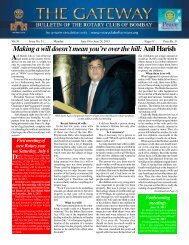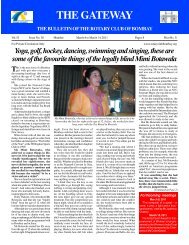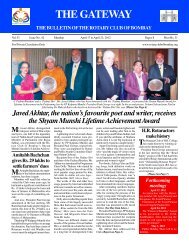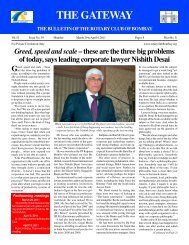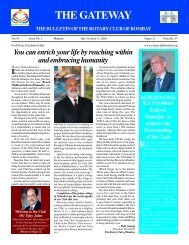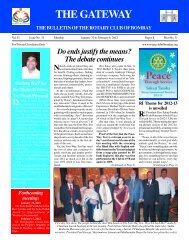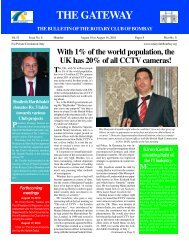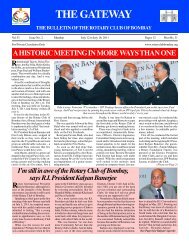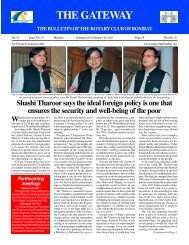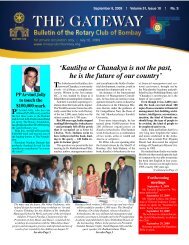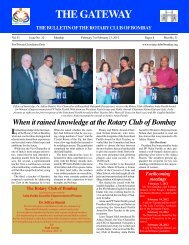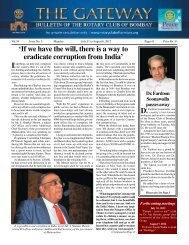You also want an ePaper? Increase the reach of your titles
YUMPU automatically turns print PDFs into web optimized ePapers that Google loves.
Vol. 54 Issue No. 9 Mumbai August 28 to September 3, 2012 Pages 8 Price Rs. 3/-There’s no dearth <strong>of</strong> money – it always follows innovative ideas,says real estate baron Niranjan HiranandaniThis is the simple story that’s probablyknown to most people, butnonetheless needs to be retold toemphasise the fact that money is notthe most important thing in life. Andthat those who think that it is, are livingin a fool’s paradise.When the BJP-Shiv Sena led a coalitiongovernment in Maharashtra, itbuilt the <strong>Bombay</strong>-Pune Expresswayas also 35 flyovers over the two ExpressHighways leading to <strong>Bombay</strong>city. The total cost <strong>of</strong> these projectswas estimated at Rs. 3,000 crores (Rs.1,350 crores for the flyovers and Rs.1,650 crores for the Expressway).Even though the government had nomoney, it created a company, theMaharashtra State Roadways DevelopmentCorporation (MSRDC), appointedan able IAS <strong>of</strong>ficer, Mr. R.C.Sinha, as MD and CEO and asked it togo ahead and implement projects worthRs. 3,000 crores.However, there was another roadblock.Bankers insisted that the governmentwould have to put in somethingto run the show and asked it tocome up with some equity.And how much did the governmentput in? A mere Rs. 5 crores!With that paltry equity, theMSRDC went ahead and, 15 yearsago, built the <strong>Bombay</strong>-Pune Ex-Ashish and Arvindto address membersFellowship Chairman PP AshishVaid and Attendance ChairmanArvind Agarwal will speak for fiveminutes each at the meeting <strong>of</strong> September4 on the activities carried outby their respective Committees duringthe months <strong>of</strong> July and August.This is in fulfilment <strong>of</strong> PresidentNowroze Vazifdar’s promise to haveall Directors reporting to membersabout the activities being undertakenby the Committees in their charge.Accordingly, Framroze Mehta, Director,<strong>Club</strong> Services (Programmes/Meetings) has requested Ashish andArvind to give a brief report on theirrespective activities.He’s a die-hard believer in a bright future for India, a country blessed witheager, ambitious and innovative young entrepreneurs. Mr. NiranjanHiranandani speaks at the last meetingpressway and 35 flyovers over thetwo Highways in <strong>Bombay</strong>.The moral <strong>of</strong> the story, according tothe narrator, Mr. Niranjan Hiranandani,the creator <strong>of</strong> the iconic HiranandaniComplex in the once-barren Powai, isthat money is not the most importantthing in life.“Whether it’s housing, whether it’sre-housing, infrastructure or new concepts,money will follow innovativeideas wherever we can create them,whether in government or the privatesector, whether you are putting up ahospital, a building or industry.“Money is available for any innovativebusiness, good people are not.Leadership is lacking. We do not havethe foresight or vision to do things thatwe want to do. If we put the rest <strong>of</strong>these components together, we cansave lives, we can have the youngest<strong>of</strong> people deliver, we can get ideas fromwomen who may otherwise not lookeducated...“Our country has a great future becausewe have the hearts, minds andsouls that are going to surpass andmake the great India <strong>of</strong> tomorrow. Ihave great hope for the future and Ihave a great belief that we will succeed,but you have to lead because youare the leaders <strong>of</strong> this great country, <strong>of</strong>this great city.”As a final punch line, Mr. Hiranandanipointed out that Ministers anddepartments <strong>of</strong> the government wereclever enough 15 years ago to successfullyexecute projects worth Rs. 3,000crores with the help <strong>of</strong> measly equity.Even Mr. Mukesh Ambani would behard pressed to match such a returnon investment in terms <strong>of</strong> realisation.Mr. Hiranandani, who was the guestspeaker at the last meeting, was introducedby PP Ashish Vaid who saidthat he was “the best producer” <strong>of</strong>commercial and housing premises inIndia. He exuded “leadership, brillianceand an untiring zest for excellence andis also down to earth”. He had alsodiversified into education, horticulture,hospitality, entertainment and retail.What he did not point out was thatthe speaker was witty, optimistic anda die-hard believer in an extremelybright future for India, a countryblessed with eager, ambitious and innovativeyoung entrepreneurs whowere bound to take the country to evengreater heights.Mr. Hiranandani exceeded all expectationswhen he spoke, delivering afree-wheeling talk and surprising memberswith a self-deprecating sense <strong>of</strong>humour seldom found in a person engagedin one <strong>of</strong> the most difficult (andcriticised) sectors in the world, viz.,building and construction.One <strong>of</strong> the two sons <strong>of</strong> the eminentENT surgeon and recipient <strong>of</strong> thePadma Bhushan, Dr. L.H. Hiranandani,he had recently taken over asPresident <strong>of</strong> the Indian MerchantsChamber, with inclusive growth as histheme for the year.When he entered the real estate sector“by accident” after failing in textiles,he had found the situation to beboth exciting and challenging.“In the beginning, I was myfather’s son; but the moment I gotinto the real estate business, I wassuddenly akin to Haji Mastan,Yusuf Patel, Dawood and othersbecause I was a ‘builder’. I had towork very hard to overcome thenegativism about builders.”Recalling his time in textiles, he saidhe had signed many hundis and borrowedcapital at 2.5% interest, apartfrom borrowings from banks. But onefine day he got a notice from the unionin his factory asking for 100% increasein wages. That was when he decidedto sell the textile unit.The late Mr. D.M. Harish, father <strong>of</strong>Anil Harish, helped him to sell <strong>of</strong>f thefactory within two months <strong>of</strong> the noticefrom the union – and he became areal estate person.When he started the MaharashtraChamber <strong>of</strong> Housing Industry, he hadto serve as its Secretary for 14 yearsbecause “nobody wanted to be the secretary<strong>of</strong> a builders’ association”. Today,<strong>of</strong> course, builders would be readyto shoot each other to become secretaryor president <strong>of</strong> the same chamber.In other words, he had helped make adifference.(Continued on Page 2)ForthcomingmeetingsAugust 28, 2012The Pravinchandra Gandhi Awardfor Excellence in Public Life to bepresented to Mr. Rahul Bajaj.Mr. Bajaj will address the <strong>Club</strong>after receiving the award.September 4, 2012The Somchand Parikh award forBest Teacher to be presented to MsRoshan Curmally <strong>of</strong> West WindSchool.
Niranjan Hiranandani reveals how he was forced to getinto education, medicine and Go-Karting(Continued from Page 1)Mr. Hiranandani said that when hestarted the Powai development projectin 1987, he had called his chief engineer,who had earlier served as chiefengineer with two <strong>of</strong> the most prominentcompanies in <strong>Bombay</strong>’s real estatebusiness. He was told that thegroup wanted to make ro<strong>of</strong>s that didnot leak in the monsoons and bathroomsthat did not leak otherwise. Theman just smirked and walked away.Two days later, when askedwhether he had come up with a planto do that, he said, “Builders nevermake buildings which don’t leak, sodon’t fool yourself; you don’t need todo it, people will buy your house, anywhich way”.“We were shocked. But then thatwas what the builders were doing inthe marketplace and that was what wewere supposed to do, too. But wechanged all that and guaranteed thatfor ten years ro<strong>of</strong>s wouldn’t leak; andwe decided that if bathrooms had problems,we would repair them free <strong>of</strong>cost; and if they still leaked, we wouldbreak them down and redo them.“We started that practice and thatwas another huge change. Of course,we still have problems <strong>of</strong> leakages butit’s a quarter <strong>of</strong> 1%, or even less thanthat, in terms <strong>of</strong> how we perfected it.”Another problem that Mr. Hiranandanifaced when he started work atPowai was that there were no goodschools (now there were seven, including<strong>Bombay</strong> Scottish). He <strong>of</strong>fered togive land free <strong>of</strong> cost to anybody willingto put up a school. But back thennobody wanted to put up a goodschool; they said they would put upordinary schools because peoplewould not pay for them. (If he <strong>of</strong>feredland free today, he would have a riot athis <strong>of</strong>fice.)Therefore, he had perforce to getinto education and set up the HiranandaniSchool that was doing extraordinarilywell today. He wanted tobenchmark it with the best. Since hehad studied at Campion, he wanted tobenchmark it with Campion. He “stole”a teacher and even an ex-Principalfrom Campion in order to clone thegood practices that were common there.(As an aside, he added, he hoped oneday to “steal” Indu Shahani.)Next on the menu was entertainment.The residents <strong>of</strong> Powai wantedit; but when he asked people to dosomething in that regard, nobody cameforward. So he had to step forwardonce again. And soon he became theowner <strong>of</strong> a video games parlour, a bowlingalley, a Go-Karting track and arock-climbing school.All these were taken up in order tocreate a “destination”, hence he madethe best possible Go-Karting trackwhich was now recognised as a championshiptrack; when he set up a videogames parlour, it became the best inthe place.Mr. Hiranandani recalled going to afriend’s house for dinner and being introducedto the child <strong>of</strong> the family as“Mr. Niranjan Hiranandani, the bigbuilder from Powai”. The child lookedaway and paid little attention to him.But when his mother added as an afterthought,“Oh, he also runs the Go-Karting track at Powai”, the child turnedaround and exclaimed, “You ownthe whole Go-Karting track? MyGod! You must be the biggest personin the world. Do you own that Go-Kart that has got a twin engine?”He did not know it but the childknew that there was a Go-Kart withtwin engines at the track.What this little tale showed was thatdifferent people had different perspectivesand that they looked at thingsfrom their own points <strong>of</strong> view. Justlike that little child changed his opinionon learning about the Go-Kartingtrack, those who visited his schoolslooked at him differently, as did thosewho had to visit his hospital.Speaking <strong>of</strong> which, Mr. Hiranandanisaid that many years ago,a young man had died in Powai becausehe could not reach a hospital.It was then that a thought struckhim – if not a hospital, at least anemergency unit, providing urgentcritical care, was essential so thatpatients could be stabilised beforebeing transferred to a bigger, betterhospital.Once again, he had to step in anddecided to open a small centre, a nursinghome with an ICU and to investRs. 5 crores to build the centre... justas he had had to build the school, theentertainment centre, the retail sectionand so on.“Like fools, we started with a smalldesign <strong>of</strong> a hospital – but finally whatwe built was a 150-bed hospital. Weput in Rs. 70 crores instead <strong>of</strong> Rs. 5crores and built the hospital in threeyears. Soon, it was overflowing, sowe put in another Rs. 70 crores, thus atotal <strong>of</strong> Rs. 140 crores, plus some Rs.5 crores in interest at the beginning.And now we have a 240-bed hospital,a super-specialty hospital which takescare <strong>of</strong> most <strong>of</strong> the patients’ needs.“When we built the hospital, wesaid we wanted to put up one <strong>of</strong> thebest hospitals... The objective was notto be better than any other hospital,just that the hospital that came up inPowai would be the best, without lookingat any other hospital. We got a lot<strong>of</strong> help from many people, from<strong>Bombay</strong> Hospital, Jaslok Hospital,Breach Candy and others. All <strong>of</strong> themshared ideas (because <strong>of</strong> my father, <strong>of</strong>course) and we incorporated themamong our best practices.“In another departure, the hospitalinducted a lot <strong>of</strong> full-timers in comparisonto other hospitals in South<strong>Bombay</strong> (which have Honoraries).My father was not very happy butwe managed to persuade him and setup one <strong>of</strong> the finest hospitals. In 2010,the hospital won the award for theBest Quality Hospital in India, theRamakrishna Bajaj (Award) and thenit won the Asia Pacific Award for theBest Quality Hospital in Asia.”Mr. Hiranandani recounted anothertrue incident at this stage. A few daysback, a woman from the IIT campuswas brought into the casualty department<strong>of</strong> the hospital. The nurse sawher immediately and was about towrite “zero pulse” on her papers. Butshe had a second look at the patient’seyes. She then picked up the CPR(cardio-pulmonary resuscitation)equipment and put it on the patient’schest, thus passing an electric current.The patient came back to life. Thenurse called a cardiac physician andthe patient was taken in 15 minutes tothe cardiac department. An angioplastywas done and the patient returnedhome five days later, alive andkicking. All this was achieved by anurse. Had a doctor done it, he wouldn’thave been impressed.What this showed was that thetraining given to the nurse to handlesuch patients had made her alert enoughto spot the little difference at 3.30 amthat morning that saved a life.In the same vein, another story wasabout a little boy who was brought tothe hospital by his mother. When hewas told that he would be seen by adoctor for his earache, he refused tobelieve that the place was a hospitalbecause it neither looked like norsmelled like a hospital.And that, said Mr. Hiranandani, hadbeen the intention right from the beginning,that the hospital “shouldn’tlook like a hospital, it shouldn’t smelllike a hospital, it shouldn’t be like ahospital, but it should work like a hospitaland a very efficient one at that”.Interestingly, his father now spentmost <strong>of</strong> his time in the Presidentialsuite <strong>of</strong> the hospital rather than in hisbeautiful house on Malabar Hill. Hewas 95 years old and in good health.But he loved the ambience (and thenurses, too) and so lived there.Mr. Hiranandani thanked Providencefor giving him “directions” thatchanged the course <strong>of</strong> his life. Whetherit was the union leader’s notice in histextile unit, or the chief engineer’s baldclaim that ro<strong>of</strong>s would always leak,the challenge <strong>of</strong> setting up a school, anentertainment centre and so on inPowai, he believed that he had been“blessed by the Almighty God”.From that he moved on to his tenureas President <strong>of</strong> the Indian Merchants’Chamber and stated that hehad no idea about what he could do inthat capacity. But he soon realised thatso long as one was prepared to do“good things”, then it was not the fieldthat one was associated with that mattered,but the will to really do something,because each one was capable<strong>of</strong> doing something.(Continued on Page 6)One day he will ‘steal’ Indu Shahani (from her educational institute),Mr. Niranjan Hiranandani warned at the last meeting. At left is his ‘disciple’PP Ashish VaidAugust 28 to September 3, 2012 THE GATEWAY, The Bulletin <strong>of</strong> the <strong>Rotary</strong> <strong>Club</strong> <strong>of</strong> <strong>Bombay</strong> Page 2
August 28 to September 3, 2012 THE GATEWAY, The Bulletin <strong>of</strong> the <strong>Rotary</strong> <strong>Club</strong> <strong>of</strong> <strong>Bombay</strong> Page 4
August 28 to September 3, 2012 THE GATEWAY, The Bulletin <strong>of</strong> the <strong>Rotary</strong> <strong>Club</strong> <strong>of</strong> <strong>Bombay</strong> Page 5
‘JUST CREATE SURPLUSES AND YOURHOSPITALISATION COSTS WILL FALL(Continued from Page 6)Then, the government <strong>of</strong> Maharashtrahad succeeded in building the<strong>Bombay</strong>-Pune Expressway and 35flyovers over the two Express Highwaysleading to <strong>Bombay</strong> – whenprojects worth Rs. 3,000 crores wereexecuted with the help <strong>of</strong> a minusculeequity <strong>of</strong> Rs. 5 crores.He was then ready to take questions.S.K. Mitra made two comments, one<strong>of</strong> them in the form <strong>of</strong> a suggestion.First, he noted that the story behindthe naming <strong>of</strong> the Powai hospital wasquite interesting. Second, he pointedout that if skill development for “ayahbais”was taken up on a large scale, itcould be turned into “a huge exportableproduct” as shown by the Filipinasand the Sri Lankans, given India’shuge population and the current accountdeficit.Mr. Hiranandani first took up thehospital naming episode. He said hehad named it after his father eventhough he was still alive. Many people,including his father, had asked him thesame question.To which he had replied, “I’m veryselfish. If you had died and gone up,then you would have looked down andbeen very happy that your son hadnamed a hospital after you and smiled.But I have named it now, while youare alive, so that I can see your smile!I’m selfish, I just wanted you to smilewhen I put up the name-board <strong>of</strong> thehospital. And he did smile”.On another occasion, a visitor hadtold his father that most hospitals hadthe name <strong>of</strong> the patient, as also that <strong>of</strong>the treating doctor, outside every door.Why was this not done at his hospital?Dr. L.H. Hiranandani had floored theman by saying, “When you put yourname outside your bungalow, you don’talso put it up outside your bedroom.My name is there outside this building(the hospital)!”Turning to skill development for“ayah-bais”, he said the idea had originatedfrom an innocent woman whospoke from the bottom <strong>of</strong> her heart.She had made the suggestion so that itwould benefit not only her own motherbut others, too.“But see how innovative ideas comeup and how our friend (referring toS.K. Mitra) is willing to fund suchideas!”PP Arvind Jolly asked two questions.First, why didn’t <strong>Bombay</strong> havemore sloping ro<strong>of</strong>s to help solve theproblem <strong>of</strong> leaking ro<strong>of</strong>s?Second, it was nice to hear aboutgood, swanky hospitals, but the commonman, especially the middle class,was worst hit by zooming hospitalbills and the prohibitive cost <strong>of</strong> medicalcare.Mr. Hiranandani said that even ifro<strong>of</strong>s were horizontal, leakages couldbe prevented; sloping ro<strong>of</strong>s wouldhelp, but then most people used theterraces <strong>of</strong> buildings.He then <strong>of</strong>fered a detailed explanationfor the escalating cost <strong>of</strong> hospitalisation.When he started using mobile phones,he paid Rs. 16.50 a minute forincoming calls and Rs. 16.50 a minutefor outgoing ones; thus it cost Rs. 33per minute, with STD charges in additionto that. But today his driverphoned Bihar every evening at lessthan Re.1 per minute with the sameservice provider. His phone cost Rs.30,000, whereas the driver’s phonecost Rs. 2,000.“This is what happens when youcreate surpluses, whether in telecomor in food, cloth, aviation or automobiles;you will get a Nano and a Mercedesand a Bentley, too. When youdon’t create surpluses, that’s wherethe problem arises.“Medical education still hasn’treached a stage where it createssurpluses. Indu Shahani and AnilHarish are working on a project tocreate private universities. Thesewill benefit not only the top endbut also the bottom end. When youwant to do something in the field <strong>of</strong>economics or supply, all you haveto do is open up the market – andthat creates surpluses.“I remember when I used to go toDelhi 25 years ago, if I wanted to comeback a day earlier, I had to phone somebodyin the Prime Minister’s Officeto phone the GM <strong>of</strong> Indian Airlines atthe airport to get a ticket one day earlierto come back to <strong>Bombay</strong>. Today,there are ten airlines... <strong>of</strong>ten, the lowcostairlines are on time, not the others.”While he paid Rs. 18,000 for a businessclass seat, in the same flight somebodyelse would have paid just Rs.2,500. Thus, differential pricing andcosting would work, as would crosssubsidy.Mr. Hiranandani recalled that fouryears ago he had built 50,000 housesfree <strong>of</strong> cost for project affected personsand handed them over to the government.He had personally built 5,000houses against TDR, a component forbalance or residual FSI. That was anotherinnovative way <strong>of</strong> doing thingsand the cross-subsidy element hadcome into play.Hospitals were also setting aside apercentage <strong>of</strong> their practice for the economicallyweaker sections, but it wasnot enough; much more needed to bedone in every possible field. But thekey word was creating surpluses.The policies in the case <strong>of</strong> educationwere so narrow and unnerving thatfew could expand the way theywanted to – even though it was possibleto cater both to the rich and thepoor at the same time, as had happenedin aviation, telecom, food andso on.Tata Motors made Land Rovers andJaguars, and the Nano, too. It was notthat the company was not making pr<strong>of</strong>itson the small car. It was indeed makingpr<strong>of</strong>its and manufacturing moresmall cars than big ones. It was a question<strong>of</strong> how one structured things.The vote <strong>of</strong> thanks was proposedby Indu Shahani.Solar Power –the DominantOption in IndiaSome interesting factsfrom the EnvironmentCommittee <strong>of</strong> the <strong>Rotary</strong><strong>Club</strong> <strong>of</strong> <strong>Bombay</strong>Thanks to Kiran NandaWe didn’t havethe green thingback in our daysAt the cash register <strong>of</strong> the store,the young cashier suggested tothe older woman that she shouldbring her own shopping bags becauseplastic bags weren’t good for the environment.The woman apologisedand explained: “We didn’t have thisgreen thing back in my earlier days.”The cashier responded: “That’sour problem today. Your generationdid not care enough to save our environmentfor future generations. Youdidn’t have the green thing.”She was right – our generationdidn’t have the green thing in itsday.Back then, we returned milkbottles, s<strong>of</strong>t drink bottles and beerbottles to the store. The store sentthem back to the plant to be washedand sterilized and refilled, so it coulduse the same bottles over and over.So they really were recycling.We refilled writing pens with inkinstead <strong>of</strong> buying a new pen and wereplaced the razor blades in a razorinstead <strong>of</strong> throwing away the wholerazor just because the blade got dull.But we didn’t have the greenthing back in our day.We walked up the stairs, becausewe didn’t have an escalator in everyshop and <strong>of</strong>fice building. We walkedto the grocery store and didn’t climbinto a 300-horsepower machine everytime we had to go two blocks.But she was right. We didn’thave the green thing in our day.Back then, we washed the baby’snappies because we didn’t have thethrow-away kind. We dried clotheson a line, not in an energy-gobblingmachine burning up 220 volts. Windand solar power really did dry ourclothes back in our early days.Kids got hand-me-down clothesfrom their brothers or sisters, not alwaysbrand-new clothing.But that young lady is right.We didn’t have the green thingback in our day.And how have you been? Hon. Secretary Sitaram Shah greets Ashok Jatiaas Mr. Niranjan Hiranandani looks on at leftAugust 28 to September 3, 2012 THE GATEWAY, The Bulletin <strong>of</strong> the <strong>Rotary</strong> <strong>Club</strong> <strong>of</strong> <strong>Bombay</strong> Page 7
ROTARY CLUB OF BOMBAYFOUNDED 19 MARCH, 1929Charter No. 3128, Dated 08 May, 192997-B, Mittal Tower, Nariman Point,Mumbai 400 021, INDIATel.: +91-22-2202 4089Fax.: +91-22-2202 4509rotaryclubbombay1@gmail.comOFFICE-BEARERS 2012/13PRESIDENT NOWROZE VAZIFDARImmediatePast President Paul GeorgePresident-Elect Nirav ShahVice-President Ramesh NarayanHonorary Secretary Sitaram ShahJoint Hon. Secretary Hiren KaraHon. Treasurer Ishraq ContractorCLUB SERVICE: New MembersDirector in charge Nirav ShahMembership PP Sandip AgarwallaClassifications PP Dr. Adi DasturInformation PP Dr. Kekoo KavaranaMembershipDevelopment &District Conference Ramesh NarayanCLUB SERVICE: Programmes/MeetingsDirector in charge Framroze MehtaAttendance Arvind AgarwalProgramme PP Haresh JagtianiFellowship PP Ashish VaidBulletin, Website& Public Relations PP Arun SanghiSergeant-at-Arms Roda BillimoriaCOMMUNITY SERVICE: Medical – IDirector in charge Dr. Percy ChibberChairman Emeritus,Talwada PP Dr. Rahim MuljianiHTEC, Talwada PP Dr. Rumi JehangirADMC, Talwada Dr. Sorab JaveriOral Health Dr. Rajeev NarvekarCOMMUNITY SERVICE: Medical – IIDirector in charge Dr. Vandana BulchandaniControl <strong>of</strong> TB Dr. Rohini ChowguleCancer Aid Zinia LawyerHeart Care and Health Dr. Aashish ContractorPolioPlus &Differently Abled Shyyamniwas SomaniCOMMUNITY SERVICE: Non-MedicalDirector in charge Sunny PariyaramOld Age Homes/Senior Citizens Naresh Kumar JainRural Development Dilnavaz VariavaEnvironment Jagdish MalkaniVOCATIONAL SERVICEDirector in charge Shernaz Vakil<strong>Rotary</strong> & Public Awards Ram GandhiFour-Way Test andMoot Court Contest Suhail NathaniVocational Training &Night Study Centres Bimal MehtaINTERNATIONAL SERVICEDirector in charge Ashok Minawala<strong>Rotary</strong> Foundation &Matching Grants PP Arvind JollyR.I. Programmes &Slumber Kit PP Rajnikant ReshamwalaNEW GENERATIONS: EducationDirector in charge Madhusudan DagaBhavishya Yaan Manish ReshamwalaScholarships & Loans Manojj Kumar PatodiaManagement Studies Poonam KumarNEW GENERATIONS: YouthDirector in charge Arjun JollyInteractMeera AlrejaRotaractRavindra FotedarRoad Safety Deepak Kapadia(Date <strong>of</strong> Publication: First day <strong>of</strong> every week) Regd. No. MH/MR/South-109/2012-14; R.N.I. No. 14015/60Posted at Mumbai Patrika Channel Sorting Office, Mumbai 400 001, on Monday, August 27, 2012His scooters have travelled a longway, but he hasn’t lost steamMr. Rahul Bajaj, who will be presentedwith the PravinchandraGandhi Award for Excellence in PublicLife at the meeting <strong>of</strong> August 28, chairsthe 86-year-old Bajaj Group, the conglomeratebest known for its motorcyclesproduced by the flagship BajajAuto.Now run by one <strong>of</strong> his sons, Rajiv,it is poised to increase market shareagainst rival Hero Group which separatedfrom Honda last year. It has alsobeen developing a small car withRenault Nissan but recently unveiledthe prototype <strong>of</strong> a mini car aimed atcustomers <strong>of</strong> three-wheeler auto rickshaws.Bajaj Allianz, the group’s insurancearm, is run by his younger son, Sanjiv,and has a distribution alliance withBerkshire Hathaway’s Indian arm.Born in 1938, Mr. Bajaj is also apolitician and philanthropist. A Member<strong>of</strong> Parliament (Rajya Sabha), hewas decorated with the country’s thirdhighest civilian award, the PadmaBhushan, in 2001.Mr. Bajaj is an alumnus <strong>of</strong> HarvardBusiness School, USA; St. Stephen’sCollege, Delhi; Government Law Col-lege, <strong>Bombay</strong>; and Cathedral and JohnConnon School, also in <strong>Bombay</strong>.He took over the reins <strong>of</strong> the BajajGroup in 1965 and under his stewardshipthe turnover <strong>of</strong> Bajaj Auto hasrisen from Rs. 72 million to Rs. 46.16billion.He created one <strong>of</strong> India’s best companiesin the difficult days <strong>of</strong> the licence-permitraj, establishing factoriesat Akurdi and Waluj. In the 1980s, BajajAuto was the top scooter producer inIndia and its Chetak brand had a tenyearwaiting period.His grandfather, Mr. Jamnalal Bajaj,was a freedom fighter and a close associateand follower <strong>of</strong> MahatmaGandhi who “adopted” him as a son.The Bajaj Group was established in1926 by Mr. Jamnalal Bajaj and todayhas 24 companies, including six thatare listed. Several institutions bear hisname, including the Jamnalal Bajaj Institute<strong>of</strong> Management Studies,<strong>Bombay</strong>. The Jamnalal Bajaj Awardwas established in 1978 by the JamnalalBajaj Foundation and is presentedevery year on his birth anniversary.Mr. Rahul Bajaj will address the<strong>Club</strong> after receiving the Award.Happy BirthdayPoonam KumarAugust 31Rajas DoshiSeptember 1Vijay MeghaniAugust 31Mudit JainSeptember 3SpousesNawaz PochkhanawallaAugust 20Usha AgarwalAugust 28Justice Sujata ManoharAugust 28Naju ColahAugust 30Indu KothariSeptember 1Sudha NevatiaSeptember 1Papri MehtaSeptember 2Neeta GujarathiSeptember 3Devi NarayanSeptember 3Brinda ShahSeptember 3Editorial Consultant: Anmol Purohit,Sajjan Sons, 203/204 Triveni, MithChowki, Marve Road, Malad (West),Mumbai 400 064. Cell: 09322227026;Landline: 022-28880712E-Mail: anmolsp@gmail.comRegd. No. MH/MR/South-109/2012-14, R.N.I. No. 14015/60Posted on Monday, Aug. 27, 2012Printed, Published by Rtn. PP Arjun Bulchandani on behalf <strong>of</strong> <strong>Rotary</strong> <strong>Club</strong> <strong>of</strong> <strong>Bombay</strong> and printed at Nikeda Art Printers Pvt. Ltd., Unit No.H & I,Kanjur Industrial Estate,Quarry Road, Off L.B.S. Marg, Bhandup (West), Mumbai 400 078 and Published at 97/B, Mittal Tower, Nariman Point, Mumbai 400 021. Editor Arjun BulchandaniAugust 28 to September 3, 2012 THE GATEWAY, The Bulletin <strong>of</strong> the <strong>Rotary</strong> <strong>Club</strong> <strong>of</strong> <strong>Bombay</strong> Page 8



